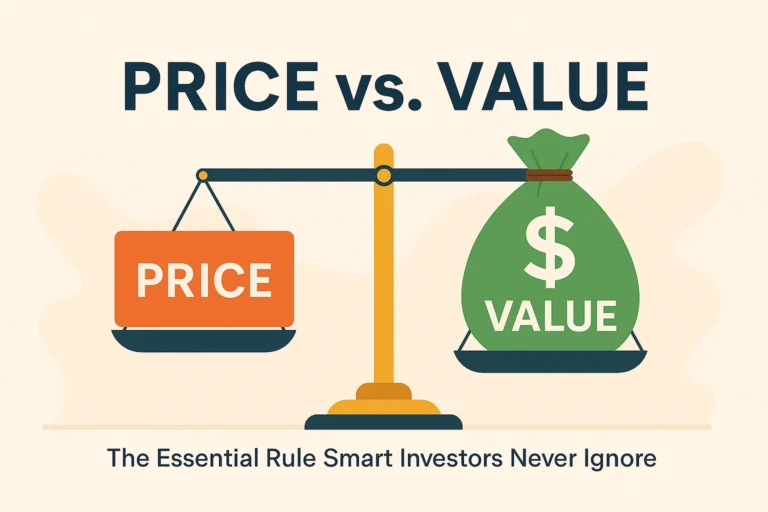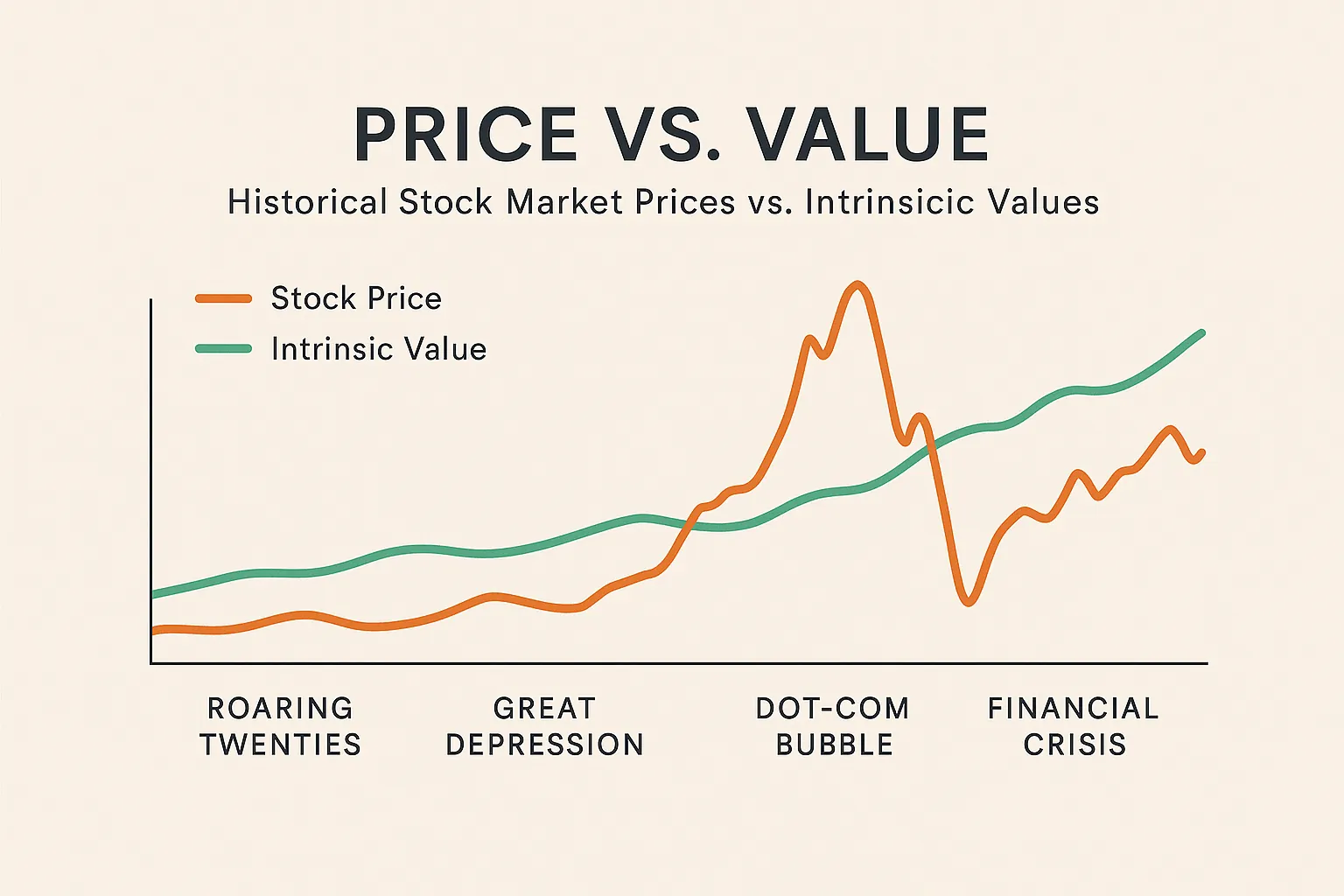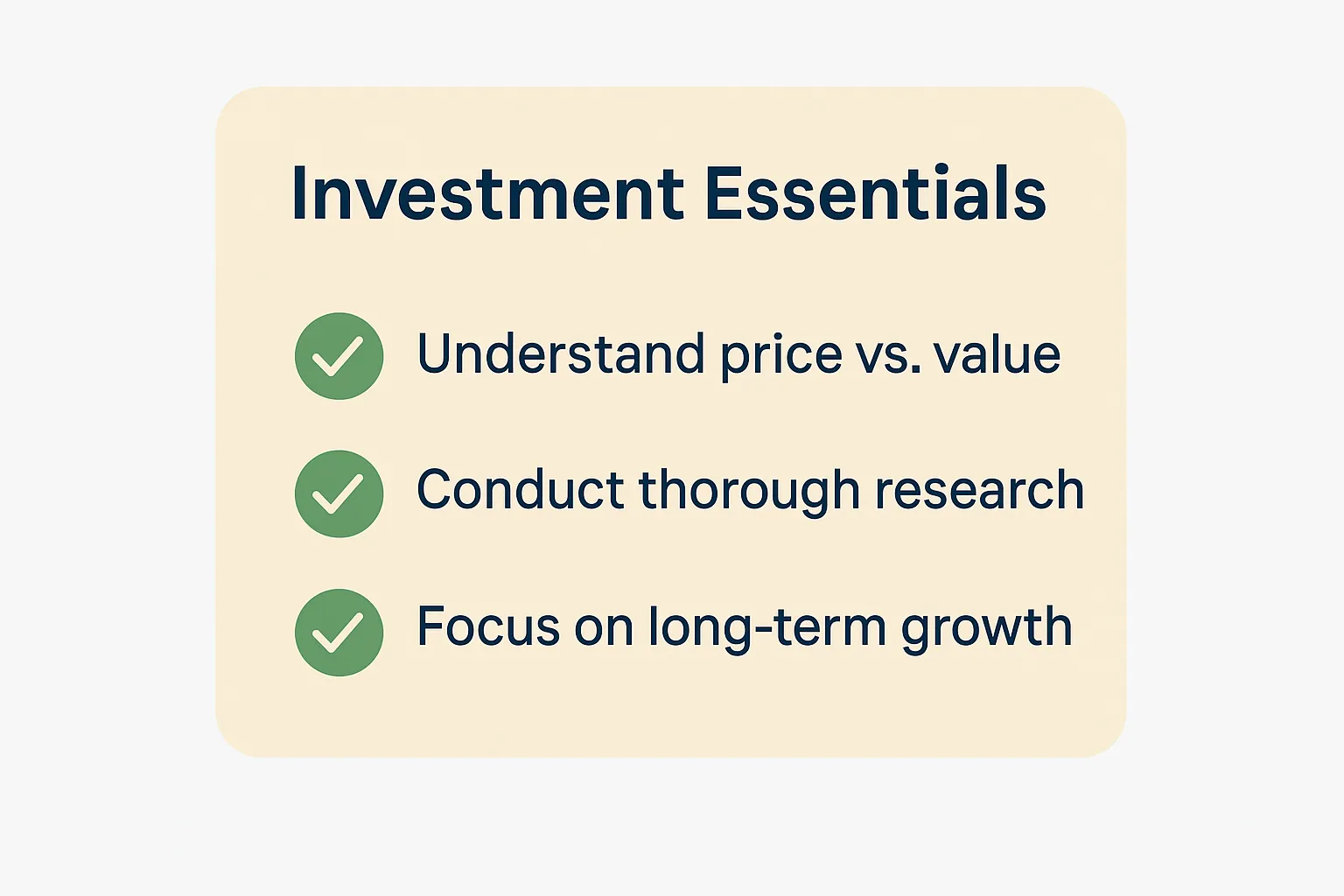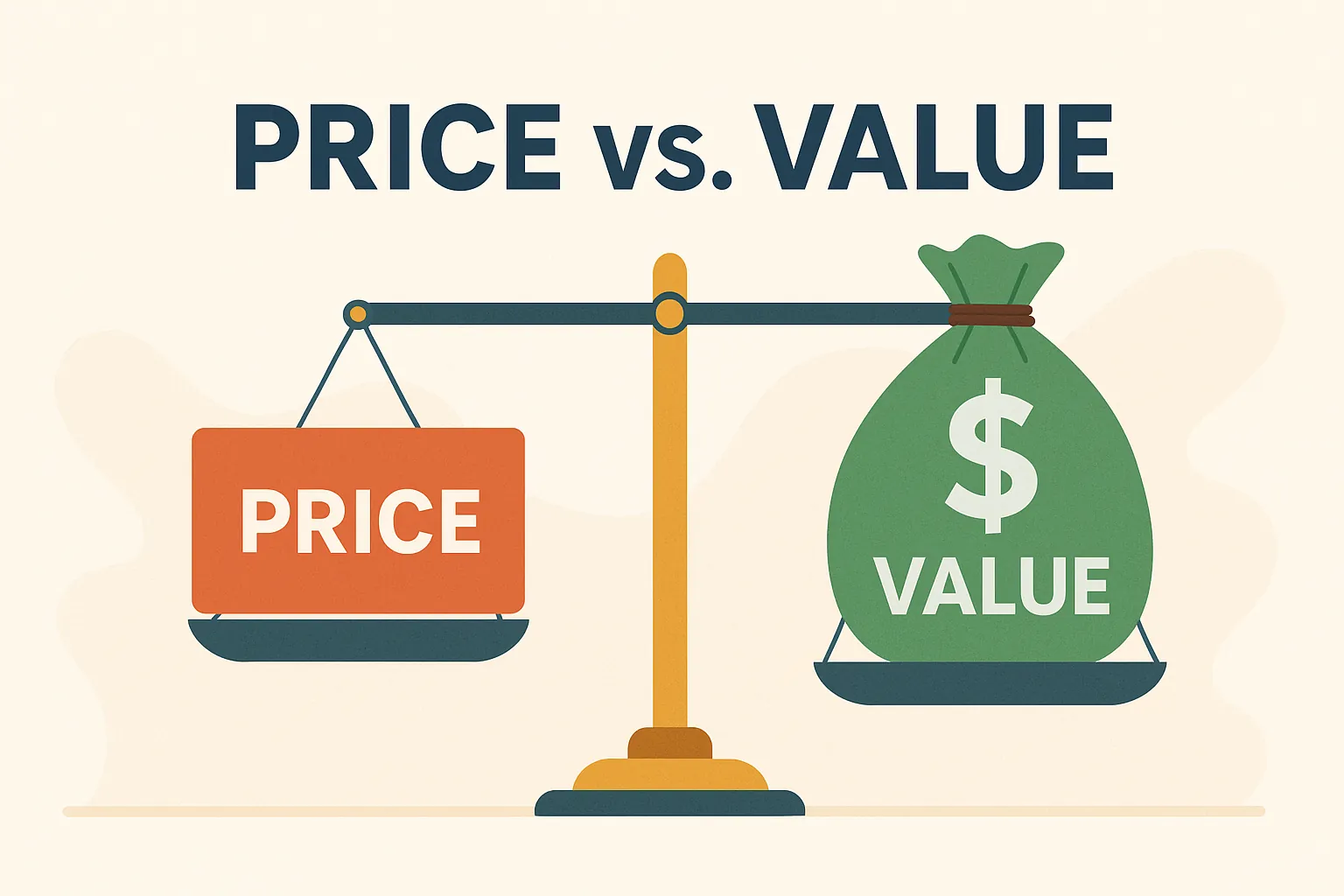Intrinsic Value — Investopedia
Clear overview of discounted cash flow, earnings power, and valuation basics.
Read the GuideLink type: dofollow

Price is what the market demands right now; value is what an asset is truly worth. Mastering the gap between the two is how you avoid hype, buy quality, and compound smarter.
Short version: Markets swing, narratives change, and headlines mislead. The antidote is a simple mental model: separate the tag on the shelf (price) from the goods in the box (value). When you train your process to estimate value first, price becomes your tool—not your guide.
The market is a voting machine in the short run—sentiment, liquidity, and headlines tug prices up and down. But your wealth compounds on the weighing of value over time. Conflating the two is how investors overpay for stories and under-own quality.
Start with a simple habit: before you look at today’s quote, define the business you’re evaluating. What do they sell, how predictable are cash flows, and what’s the competitive moat? Then cross-check how that intrinsic worth compares to the sticker price on your screen. For a deeper primer, see Understanding the Real Value of a Stock:contentReference[oaicite:0]{index=0} and this fundamentals overview Fundamentals of Stock Market Investing:contentReference[oaicite:1]{index=1}.
| Dimension | Price (Tag) | Value (Goods) |
|---|---|---|
| Driver | Supply/Demand, sentiment, liquidity | Cash flows, durability, competitive advantage |
| Time Horizon | Minutes → Months | Years → Decade |
| Primary Risk | Volatility & narrative swings | Business decay & thesis drift |
| Best Use | Timing entries/exits | Determining what to own |
Prices can be noisy. Train your process to cut the noise and prioritize signal. This short piece shows a practical approach: Use Them to Cut Down on the Noise of the News:contentReference[oaicite:2]{index=2}. Also remember that volume can move the tag without changing the goods—review How a Stock’s Volume Can Affect Its Price:contentReference[oaicite:3]{index=3}.
Clear overview of discounted cash flow, earnings power, and valuation basics.
Read the GuideLink type: dofollow
Objective resources on evaluating investments and avoiding common pitfalls.
Explore ResourcesLink type: nofollow
Choose a company you understand. Draft a one-page valuation—drivers, estimates, and a conservative range. Only then check the quote: is the market pricing your thesis above or below your conservative value? If below, you may have found an opportunity worth scaling into. For portfolio design principles that help you execute, skim Build a Diversified Stock Portfolio:contentReference[oaicite:4]{index=4} and a framing piece on trading style fit Day Trading vs. Swing Trading:contentReference[oaicite:5]{index=5}.
Next up: a concise history of price & value thinking and how bubbles teach the same lesson every cycle.
Understanding how the concept of price vs. value evolved helps you see why value investing endures despite countless market fads. The distinction dates back to the early 20th century, when Benjamin Graham introduced his intrinsic value framework. His teachings influenced investors like Warren Buffett, who built fortunes by buying stocks below their real worth.
In the roaring 1920s, price often soared far above value — a gap that closed violently during the Great Depression. Decades later, the dot-com bubble of the late 1990s echoed the same lesson: companies with no earnings but sky-high stock prices eventually saw their market tags crash to align with reality. To understand modern comparisons, see Stocks vs. Real Estate — Which Investment Is Right for You?:contentReference[oaicite:0]{index=0} for how asset types balance price and value differently.

Consider the 2008 financial crisis. Financial stocks that traded at sky-high valuations suddenly looked overvalued when underlying mortgage-backed securities collapsed. Those who had studied the underlying value saw the warning signs early. For a similar approach in personal portfolio planning, review Build a Diversified Stock Portfolio:contentReference[oaicite:1]{index=1}.
Foundational book explaining intrinsic value, margin of safety, and disciplined investing.
View on AmazonLink type: dofollow
Academic breakdown of asset price inflation and subsequent corrections across centuries.
Read JournalLink type: nofollow
Knowing the history of price vs. value empowers you to spot when the crowd is likely wrong. Whether in the tulip mania of the 1600s or the cryptocurrency booms of the 2010s, the same underlying psychology fuels the disconnect between the tag and the goods. Armed with this perspective, you can better navigate modern opportunities and risks.
Next: We’ll explore practical tools and metrics to identify value beyond the price tag.
Spotting value means going deeper than a flashing ticker. It’s the discipline of analyzing fundamentals and separating hype from true worth. In practice, this involves a blend of **quantitative metrics** and **qualitative insights** that, together, build a realistic picture of a company’s future earning power.
Smart investors don’t just ask, “What’s the stock price?” — they ask, “What am I getting for that price?” For a structured approach, revisit Build a Diversified Stock Portfolio:contentReference[oaicite:0]{index=0} for tips on balancing risk while targeting true value opportunities.
But numbers alone don’t tell the full story. **Qualitative factors** like brand strength, innovation capacity, regulatory environment, and management quality often tip the scales. In competitive industries, a company with a strong moat can justify a higher price because the underlying value is resilient.
Imagine two retailers: Company A has a low P/E but is losing market share; Company B trades at a higher P/E but is expanding rapidly and innovating its product line. While the sticker price says A is cheaper, the underlying value case may favor B if growth and profitability sustain.
Comprehensive guide to discounted cash flow, relative valuation, and economic moat analysis.
Read the GuideLink type: dofollow
Overview of ratio analysis, profitability metrics, and interpreting financial statements.
Explore CourseLink type: nofollow
Next: Real-world case studies that reveal how price and value play out in practice.
Case studies bring the price vs. value debate to life. By analyzing past winners and losers, we see how market perception can diverge wildly from intrinsic worth — and how disciplined investors can profit from those gaps.
In 2014, Amazon’s P/E ratio hovered around 500 — a number that scared away value purists. Critics claimed the stock was “overpriced,” but long-term investors who understood its business model saw that cash flow growth, market dominance, and relentless reinvestment justified the valuation. A decade later, those buyers enjoyed returns that dwarfed the market average.
GE was once the crown jewel of American industry. In the early 2000s, its stock price reflected a near-perfect reputation. But under the surface, hidden debt risks and declining core profitability eroded real value. When the 2008 financial crisis hit, the market corrected sharply — teaching investors that a high price tag doesn’t always signal quality.
Many penny stocks appear “cheap” because of their low share prices. In reality, they may have minimal revenues, poor management, and no clear growth plan. As explored in Best Penny Stocks to Buy Now:contentReference[oaicite:0]{index=0}, genuine bargains require thorough research to separate opportunity from speculation.

In-depth analysis of common valuation misjudgments and how to avoid them.
Read ArticleLink type: dofollow
Real-world examples where the gap between price and value created opportunity or disaster.
Visit FTLink type: nofollow
Next: Insights from top investors on navigating the price vs. value balance.
The most successful investors blend hard data with seasoned judgment. They understand that price vs. value is not a formula — it’s a framework that adapts to each opportunity. Here’s how some of the world’s best have approached it.
Buffett focuses on businesses with strong moats, consistent earnings, and trustworthy management. He often ignores short-term market noise, waiting for prices that offer a margin of safety. For more on strategy fit, read Day Trading vs. Swing Trading:contentReference[oaicite:0]{index=0} to see why long-term patience sometimes wins.
Munger emphasizes multidisciplinary thinking. By combining insights from psychology, economics, and history, he spots when prices are disconnected from reality — in either direction. His advice: simplify your approach, but never oversimplify the analysis.
Known as the “Dean of Valuation,” Damodaran focuses on aligning valuation methods with business type. For a tech startup, discounted cash flow may need more flexible growth assumptions; for mature companies, asset-based valuations might suffice.
In-depth articles on equity valuation, corporate finance, and market analysis.
Explore ResearchLink type: dofollow
Insights from the program co-founded by Benjamin Graham, updated for modern markets.
Visit ProgramLink type: nofollow
Next: The common mistakes traders make when comparing price and value — and how to avoid them.
Even with the right tools, many investors fall into traps when evaluating price versus value. The good news: these mistakes are predictable and avoidable if you know what to watch for.
Buying into hype or panic selling during downturns often results in paying too much for too little value — or selling valuable assets for too little price. Emotional bias is the most common destroyer of long-term returns.
A low P/E ratio doesn’t guarantee a bargain, just as a high dividend yield doesn’t ensure safety. Always use a combination of metrics and qualitative analysis to form a complete picture.
Macro trends, industry health, and competitive dynamics matter. A company may look undervalued in isolation but be operating in a shrinking market. For foundational knowledge, review Fundamentals of Stock Market Investing:contentReference[oaicite:0]{index=0}.

Explores common behavioral biases and their impact on investment decisions.
Read MoreLink type: dofollow
Real-world examples of how investors can get caught chasing price instead of value.
Read ArticleLink type: nofollow
Next: Final takeaways and a fully optimized FAQ section to solidify the price vs. value framework.
Price vs. value is more than an investing cliché — it’s the foundation of disciplined decision-making. Mastering this concept allows you to sidestep hype, avoid overpriced traps, and seize opportunities when the market misprices quality assets.
U.S. Securities and Exchange Commission resources for understanding valuation and market risks.
Visit SEC.govLink type: dofollow
Practical guidance on determining a stock’s fair value using multiple approaches.
Read ArticlesLink type: nofollow
Use a combination of valuation metrics like P/E, PEG, and discounted cash flow, but always cross-check with qualitative factors such as industry trends and management quality.
No. In bear markets or during company-specific downturns, price can drop far below value — creating potential buying opportunities.
Yes. If a company’s liabilities exceed its assets and there’s no path to profitability, its intrinsic value can be negative despite having a positive share price.
For dividend-focused investors, also explore Income Generation: Leveraging Dividends for Passive Income:contentReference[oaicite:0]{index=0} to see how value principles apply to income strategies.
With the right mindset, you can turn market mispricings into consistent long-term gains — no matter the market cycle.
Independent guidance on risks, valuation basics, and due diligence.
Visit SEC.govLink type: dofollow
Macro indicators (rates, CPI, GDP) to contextualize valuations.
Explore FREDLink type: dofollow
Professional articles on equity analysis, moats, and DCF methods.
Read ResearchLink type: dofollow
Clear explainer on valuing cash flows vs. market price.
Read GuideLink type: dofollow
Analyst perspectives on moats and fair value estimates.
See Fair ValuesLink type: nofollow
Context on market regimes where price/value diverge.
Visit FTLink type: nofollow
Common errors investors make when valuing companies.
Read HBRLink type: nofollow
Macro risks that can compress multiples unexpectedly.
GFSR ReportsLink type: nofollow
How to estimate fair value before checking the price tag.
ReadInternal link:contentReference[oaicite:0]{index=0}
Spot price moves driven by liquidity vs. fundamentals.
ReadInternal link:contentReference[oaicite:1]{index=1}
Filter headlines and focus on true value drivers.
ReadInternal link:contentReference[oaicite:2]{index=2}
Pick the style that fits your valuation/time horizon.
CompareInternal link:contentReference[oaicite:3]{index=3}
How to estimate fair value before checking the price tag.
ReadInternal link:contentReference[oaicite:0]{index=0}
Spot price moves driven by liquidity vs. fundamentals.
ReadInternal link:contentReference[oaicite:1]{index=1}
Filter headlines and focus on true value drivers.
ReadInternal link:contentReference[oaicite:2]{index=2}
Pick the style that fits your valuation/time horizon.
CompareInternal link:contentReference[oaicite:3]{index=3}